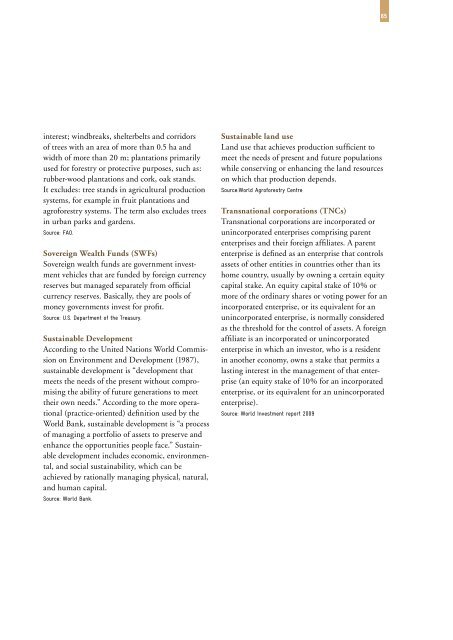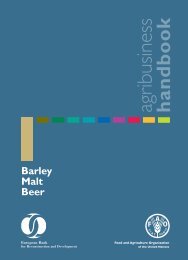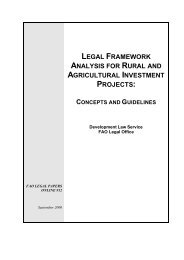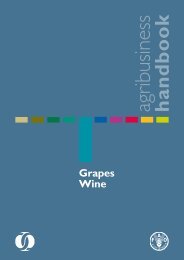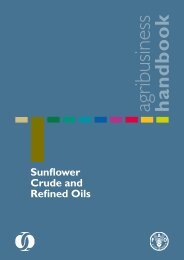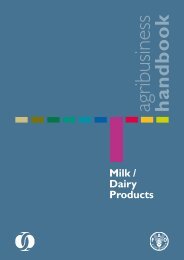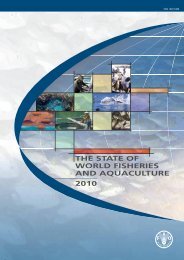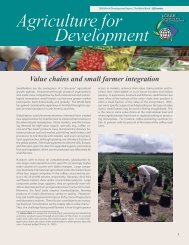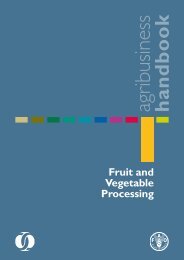64GlossaryAgro-fuelsAgro-fuels are def<strong>in</strong>ed as liquid energy sourcesproduced from agricultural commodities (e.g.from sugar, starch and oil crops), which are used<strong>in</strong> the transport sector as well as for thermalenergy generation (heat and power). Fuels fromagricultural waste and residues are less controversialand not <strong>in</strong>cluded <strong>in</strong> this def<strong>in</strong>ition.Source: GTZ.<strong>Foreign</strong> <strong>Direct</strong> <strong>Investment</strong> (<strong>FDI</strong>)<strong>Foreign</strong> <strong>in</strong>vestment <strong>in</strong>volves a last<strong>in</strong>g <strong>in</strong>terest <strong>in</strong>effective management control over an enterprise.<strong>Foreign</strong> direct <strong>in</strong>vestment can <strong>in</strong>clude buy<strong>in</strong>gshares of an enterprise <strong>in</strong> another country, re<strong>in</strong>vest<strong>in</strong>gearn<strong>in</strong>gs of a foreign owned enterprise <strong>in</strong>the country where it is located, and parent firmsextend<strong>in</strong>g loans to their foreign affiliates. InternationalMonetary Fund (IMF) guidel<strong>in</strong>es consideran <strong>in</strong>vestment to be a foreign direct <strong>in</strong>vestment ifit accounts for at least 10 % of the foreign firm’svot<strong>in</strong>g stock of shares. However, many <strong>countries</strong>set a higher threshold because 10 % is often notenough to establish effective management controlof a company or demonstrate an <strong>in</strong>vestor’s last<strong>in</strong>g<strong>in</strong>terest.Source: World Bank.Contract farm<strong>in</strong>gContractual partnership between small farmersand a process<strong>in</strong>g and/or market<strong>in</strong>g firm for thepurpose of commercial production, frequently atpredeterm<strong>in</strong>ed prices. Depend<strong>in</strong>g on the termsof contract, small farmers may receive technicalassistance, seeds, agro-chemicals and some creditfrom their contract-partners, and are ensured ofguaranteed markets, secure <strong>in</strong>come and employment.Source: HU Berl<strong>in</strong>; SLE.<strong>FDI</strong> <strong>in</strong> <strong>Land</strong><strong>FDI</strong> <strong>in</strong> land by a foreign company or state that isbased on a last<strong>in</strong>g <strong>in</strong>terest <strong>in</strong> tak<strong>in</strong>g control overland use rights. The transaction <strong>in</strong>cludes eitherrights of land use or land-ownership. The landuse rights are generally valid for a limited periodand can possibly be extended. Source: (Owndef<strong>in</strong>ition follow<strong>in</strong>g the general def<strong>in</strong>ition of <strong>FDI</strong>).Increased access to <strong>FDI</strong> is seen as one of the keybenefits of globalization because it is thoughtto lead to capital formation, technology andknowledge transfer, higher wages and greater jobopportunities. The UN Conference on F<strong>in</strong>ancefor Development argues that <strong>FDI</strong>, along with<strong>in</strong>ternational f<strong>in</strong>ancial stability, are vital componentsto national and <strong>in</strong>ternational developmentefforts. Many other <strong>in</strong>ternational policy documentsstress the value of <strong>FDI</strong> but critics areconcerned that its benefits are very unequallydistributed, both globally and with<strong>in</strong> societies.Source: WHO.Forest AreaForest area is the land spann<strong>in</strong>g more than 0.5 hawith trees higher than 5 metres and a canopycover of more than 10 %, or trees able to reachthese thresholds <strong>in</strong> situ. It does not <strong>in</strong>clude landthat is predom<strong>in</strong>antly under agricultural or urbanland use. Forest is determ<strong>in</strong>ed both by the presenceof trees and the absence of other predom<strong>in</strong>antland uses. The trees should be able to reach am<strong>in</strong>imum height of 5 metres (m) <strong>in</strong> situ. Areasunder reforestation that have not yet reached butare expected to reach a canopy cover of 10 % anda tree height of 5 m are <strong>in</strong>cluded, as are temporarilyunstocked areas, result<strong>in</strong>g from human <strong>in</strong>terventionor natural causes, which are expected toregenerate. It <strong>in</strong>cludes: areas with bamboo andpalms provided that height and canopy covercriteria are met; forest roads, firebreaks and othersmall open areas; forest <strong>in</strong> national parks, naturereserves and other protected areas such as those ofspecific scientific, historical, cultural or spiritual
65<strong>in</strong>terest; w<strong>in</strong>dbreaks, shelterbelts and corridorsof trees with an area of more than 0.5 ha andwidth of more than 20 m; plantations primarilyused for forestry or protective purposes, such as:rubber-wood plantations and cork, oak stands.It excludes: tree stands <strong>in</strong> agricultural productionsystems, for example <strong>in</strong> fruit plantations andagroforestry systems. The term also excludes trees<strong>in</strong> urban parks and gardens.Source: FAO.Sovereign Wealth Funds (SWFs)Sovereign wealth funds are government <strong>in</strong>vestmentvehicles that are funded by foreign currencyreserves but managed separately from officialcurrency reserves. Basically, they are pools ofmoney governments <strong>in</strong>vest for profit.Source: U.S. Department of the Treasury.Susta<strong>in</strong>able DevelopmentAccord<strong>in</strong>g to the United Nations World Commissionon Environment and Development (1987),susta<strong>in</strong>able development is “development thatmeets the needs of the present without compromis<strong>in</strong>gthe ability of future generations to meettheir own needs.” Accord<strong>in</strong>g to the more operational(practice-oriented) def<strong>in</strong>ition used by theWorld Bank, susta<strong>in</strong>able development is “a processof manag<strong>in</strong>g a portfolio of assets to preserve andenhance the opportunities people face.” Susta<strong>in</strong>abledevelopment <strong>in</strong>cludes economic, environmental,and social susta<strong>in</strong>ability, which can beachieved by rationally manag<strong>in</strong>g physical, natural,and human capital.Source: World Bank.Susta<strong>in</strong>able land use<strong>Land</strong> use that achieves production sufficient tomeet the needs of present and future populationswhile conserv<strong>in</strong>g or enhanc<strong>in</strong>g the land resourceson which that production depends.Source:World Agroforestry CentreTransnational corporations (TNCs)Transnational corporations are <strong>in</strong>corporated orun<strong>in</strong>corporated enterprises compris<strong>in</strong>g parententerprises and their foreign affiliates. A parententerprise is def<strong>in</strong>ed as an enterprise that controlsassets of other entities <strong>in</strong> <strong>countries</strong> other than itshome country, usually by own<strong>in</strong>g a certa<strong>in</strong> equitycapital stake. An equity capital stake of 10% ormore of the ord<strong>in</strong>ary shares or vot<strong>in</strong>g power for an<strong>in</strong>corporated enterprise, or its equivalent for anun<strong>in</strong>corporated enterprise, is normally consideredas the threshold for the control of assets. A foreignaffiliate is an <strong>in</strong>corporated or un<strong>in</strong>corporatedenterprise <strong>in</strong> which an <strong>in</strong>vestor, who is a resident<strong>in</strong> another economy, owns a stake that permits alast<strong>in</strong>g <strong>in</strong>terest <strong>in</strong> the management of that enterprise(an equity stake of 10% for an <strong>in</strong>corporatedenterprise, or its equivalent for an un<strong>in</strong>corporatedenterprise).Source: World <strong>Investment</strong> report 2009


